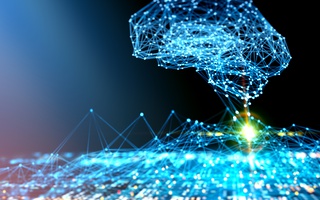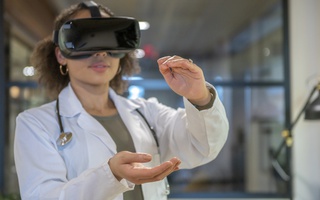Until recently, the primary trend in the development of industrial production has been the use of complex automation systems. Large enterprises have been implementing - and continue to implement - solutions based on powerful and distributed computing equipment. They control the entire production cycle, and the seamless integration of production and computing systems ensures process flexibility and enables quick changes in the manufactured products. What could be better? However, the development of AI systems promises the creation of truly disruptive automation systems.
Present-day systems rely on logic and precise calculations—they apply the simplified production process model chosen in advance. AI enables real-time situation analysis and ensures adequate system operation in case of production goal changes, or sudden unpredictable changes in the controlled object or environment parameters. The system can change the control algorithm and look for optimal and efficient solutions. I would define artificial intelligence as a domain of knowledge that automates reasonable behavior of technical systems.
Features of intelligent production systems:
- They do not use a predetermined solution algorithm to solve or coordinate tasks.
- They can detect hidden interrelations in managed systems and their parameters.
- They collect data from various systems.
- They analyze data of different types: video footage, images, signs, texts, words, etc.
- They choose from an unlimited number of variants that are not classified in advance.
Which enterprises need Artificial Intelligence
Industrial AI can be applied in almost all business verticals and all levels:
- At the design level, they can improve the efficiency of new product development, automate supplier selection and evaluation, and analyze requirements to spare parts and assembled items.
- At the production level, they can optimize business processes and coordinate (orchestrate) various production systems. AI assistants reduce the amount of human error, simplify the production process, and reduce downtime during process re-engineering. Image recognition functions can analyze the movement of employees and vehicles, thereby increasing plant safety. They can also be applied for quality control and visual equipment inspection.
- At the logistics level, they can optimize the transportation itineraries, reduce the raw material delivery time and make it predictable, as well as track the delivery processes at all stages. AI can predict shipment volume fluctuations, and interactive communication helps you build relations with customers and suppliers.
- At the promotional level, the system can predict support and maintenance service volumes, manage pricing, and analyze customer satisfaction with product quality.
It is worth noting that AI implementation does not require a dramatic change in enterprise business processes. The good thing about the existing solutions is that they help to advance quality to a brand-new level by optimizing the performance of existing systems. You can gradually add new portions of production processes into the surveillance and management contour and orchestrate them, increasing the process manageability.
How does Artificial Intelligence work?
Any AI system can be represented as a combination of very simple elements—agents that solve their specialized task. At the same time, combination and number of agents of each type can be changed not only depending on the type of solved tasks but also time, as this specific AI gains experience. There are the following types of agents:
- Engine agents collect and process information and track the equipment and staff status
- Coordinator agents ensure the interaction of agents within the information space of a specific AI
- Search agents accumulate local and (when necessary) global information from the Internet, reveal interrelations between processes, and generate results.
- Learning agents generate generalized concepts, learn from expert experience, and accumulate knowledge in a specific AI field.
- Solving agents make inferences based on given constraints and make recommendations for production systems and personnel.
The agents can operate in a different way: every one of them can have its environment (on various devices, in various systems, etc.) without knowing about the rest; they can coordinate their actions via coordinator agents; or they can use a shared information space and exchange the work results between each other.
Traditional object-oriented systems used now on the majority of large enterprises can increase the flexibility of production and other management process management but cannot control the conditions in which the placed task is solved or vary the use of resources in real-time mode. It means that they are unable to use the resources, the lists of heterogeneous systems, and their operation modes in real-time to solve the production tasks.
At present, the applied AI solutions are usually based on a class of machine learning (ML) methods that are highly effective for a broad spectrum of tasks.
How often is AI used in Russian Industry?
At the moment, few Russian companies have implemented AI in Russia, but all of them confirm the effectiveness of the technology. The customers are large mining and processing companies. We have created and continue to develop systems for occupational safety monitoring, safe transportation of moving objects at the production sites, video footage analysis to eliminate dangerous situations in the production, video-based quality control, controlling the performance of production equipment and optimizing the work of production personnel.
Our experience shows that the implementation of AI in enterprise production processes quickly pays off. For example, if you place at your production shops electronic terminals that display changes in the production order when the type of product is changed, taking into account the specific situation and the condition of the conveyor, you can reduce the idle time and the non-productive consumption of resources in a project by up to 30%. On average, the implementation of solutions in the field of occupational safety—video analytics, thermal maps, monitoring if the employees wear personal protective equipment, controlling hazardous areas—reduce the on-the-job-injury rate by 50%. Artificial Intelligence and RPA (Robotic Process Automation) are also used in electronic document management systems: they free the personnel from routine operations and speed up the correspondence processing. In reporting and banking systems, automatic application processing in ITSM systems, including the processing of handwritten text, reduces the document processing time by 80%.
When AI will become a commonplace
Now artificial intelligence is the main direction of control system development, which allows for getting the most out of existing production facilities and building new ones with even higher efficiency. Such enterprises will be able to produce unprecedentedly cheap and high-quality products, quickly and automatically changing the production cycles and product range. Therefore, all large industrial companies are more or less interested in the use of AI.
The technology will become pervasive when the implementation projects transform from "experiments" with long startup time (due to system training) to a stage of out-of-the-box implementation when the system will learn the features of specific production site without human intervention. They will rely on local data and external information resources, observe the work of employees, and provide a detailed interpretation of its inferences and decisions for a human.










